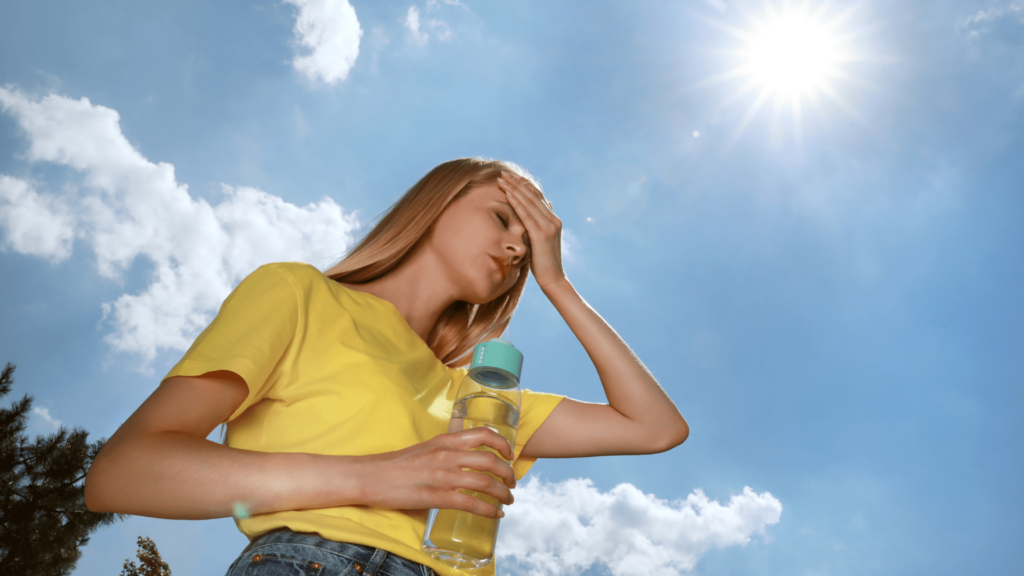Summer has arrived, and it’s time to enjoy the beach and other outdoor activities under the sun. However, it’s important not to forget to stay hydrated and rest well. Otherwise, you may be at risk of developing heat exhaustion or heat stroke, which can happen to anyone who stays in the heat and sun for too long. Many people confuse heat exhaustion with heat stroke, but there are a few differences between them. Heat exhaustion can also progress to heart stroke. Therefore, it’s crucial to monitor a person’s condition carefully if they are experiencing symptoms of heat exhaustion.
What is Heat Stroke?
Heat stroke is the most severe and least common heat-related illness. It is a life-threatening emergency that occurs when the body’s cooling system is completely overwhelmed and stops working.
During heat stroke, the body stops sweating because the levels of fluid are too low. Without sweating, the body’s temperature rises rapidly. When it gets too high, the brain and other vital organs cannot function properly. The person becomes unresponsive, has seizures, and can die without immediate first aid. Heat stroke symptoms may include:
- High core temperature, above 40℃ (104℉)
- Hot, dry skin
- Flushed (red) or pale skin
- Altered mental status (e.g., confusion)
- Rapid, shallow breathing
- Seizure or coma

What is Heat Exhaustion?
Heat exhaustion happens when the body becomes overheat, often as a result of losing more fluids and electrolytes through sweating than it gains through rehydration. This is most likely to happen after long periods of strenuous activity in a hot environment, especially in a humid or lacking air circulation, as these conditions make it difficult for sweat to evaporate.
Heat exhaustion is an early warning sign that the body’s temperature regulation mechanisms are being overwhelmed. As more blood flows to the skin to remove heat from the body’s core, less blood flows to the vital organs resulting in a mild form of shock. Heat exhaustion can progress to heat stroke. Heat exhaustion symptoms may include:
- Headache, nausea, dizziness, or fainting
- Dehydration or intense thirst
- Normal or slightly raised core temperature ( 37 to 39℃, or 98.6 to 102.2℉)
- Moist skin that is flushed (red) immediately after exertion, and then turns pale or ashen (grey).
- Weakness pr exhaustion
Inquire about First Aid Training
The Good Samaritan Act is covered in all of our First Aid & CPR courses. Learn more about it and register today! Contact our customer service team.
The Differences Between Heat Stroke and Heat Exhaustion
While the symptoms of heat stroke and heat exhaustion may appear similar. But there are several clear differences in the affected areas, including the skin, physical condition, mental state, and breathing.
Heat exhaustion | Heat stroke | |
Skin |
|
|
Physical |
|
|
Mental |
|
|
Breathing |
|
|
The signs and symptoms listed in bold in the table above are very serious. Call EMS/911 immediately if any of these are present.
How to Help Someone with Heat Stroke or Heat Exhaustion
Heat Exhaustion
- If the person is vomiting or has an altered level of responsiveness.
- Unable to drink fluids
- Reduce the person’s heat exposure
- By moving them to a cooler environment, such as a shaded area.
- Loosen any tight clothing
- Remove any padded clothing or equipment at the same time.
- Pour cool water
- On the person’s clothing and/or towels or clothes
- Place them on the person’s chest.
- Fan the person to increase evaporation.
- Apply ice or cold packs to the armpits and chest.
- If the person is responsive and able to swallow
- Have them slowly sip a cool electrolyte-replacement beverage (e.g./ commercial sports drink, coconut water, fruit juice, or milk).
- If a drink with electrolytes is not available, have the person drink water.
- Advise the person not to engage in any more activities in the heat that day.
Heat Stroke
- Get an AED (automated external defibrillator)
- Move the person to a cooler environment.
- Quickly lower the person’s core temperature with one of the following methods:
- Immerse the person in cool water from the neck down. Do not remove the person’s clothing.
- Immerse the person’s forearms and hands in cool water.
- Pour cool water on the person’s clothing and/or on towels or clothes and place them on the person’s chest. Fan the person to increase evaporation.
- Apply ice or cold packs to the person’s armpits and chest.
- Continue to use the rapid cooling methods listed above until either the person’s condition improves or EMS personnel arrive.
- If the person is responsive and able to swallow
- Have him or her slowly sip a cool electrolyte-replacement beverage (e.g., commercial sports drink, coconut water, fruit juice, or milk).
- If a drink with electrolytes is not available, give the person water.

How to Prevent Heat-Related Emergencies
- Drink plenty of cool fluids, this is the most important step you can take.
- Avoid being outside during the hottest part of the day.
- The hottest part of the day is late afternoon.
- Know the humid rating, this rating combines the temperature and humidity to indicate how hot and humid the weather feels to the average person.
- Wear light, loose clothing to let air circulate and heat escape, and always wear a hat.
- Apply sunscreen (with SPF 15 or higher) as sunburned skin reduces the body’s ability to cool itself.
- Slow down your activities as it gets hotter and don’t work, exercise, or play for too long at a time.
- Take a lot of breaks in a cool or shady area to let your body cool off. This will help if you do need to be outside when it’s really hot.

First Aid Training for Heat Stroke and Heat Exhaustion
Heat stroke and heat exhaustion are serious heat-related illnesses that can lead to seizures and comas in severe cases. If you have completed the first aid course, you will be able to stabilize and provide necessary care to the patient in need. Coast2Coast offers various first aid and CPR courses for individuals in learning life-saving skills. The Standard First Aid and CPR/AED course is a 16-hour course offering first aid and cardiopulmonary resuscitation (CPR) skills for those who need training for work requirements, or who want more knowledge to respond to emergencies at home.




















